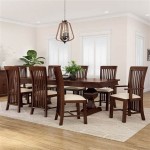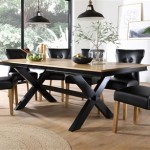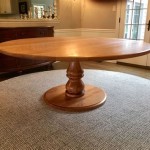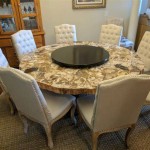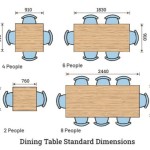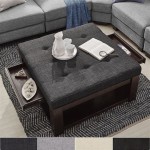Dining Table With Tile Top: A Durable and Stylish Choice
The dining table serves as a central gathering point in many homes, a place where meals are shared, conversations unfold, and memories are made. Selecting the right dining table is a significant decision, impacting both the functionality and aesthetic of the dining space. Among the diverse options available, the dining table with a tile top presents a compelling choice, offering a blend of durability, style, and practicality. This article delves into the characteristics, benefits, considerations, and maintenance aspects of dining tables featuring tile tops, providing a comprehensive understanding of why they may be an ideal addition to a home.
Dining tables with tile tops are characterized by a surface composed of individual tiles, meticulously arranged and often grouted together. These tiles can be crafted from a variety of materials, including ceramic, porcelain, stone (such as granite or marble), or even glass. The tiles are typically adhered to a sturdy substrate, such as wood or metal, providing structural support and ensuring a stable and level dining surface. The aesthetic options are virtually limitless, as tiles are available in a wide spectrum of colors, patterns, sizes, and textures. This versatility allows for seamless integration into various design styles, from rustic and traditional to modern and contemporary.
Durability and Resilience
One of the primary advantages of a dining table with a tile top is its exceptional durability. Tiles, particularly those made from porcelain or stone, are inherently resistant to scratches, stains, and heat. This makes them ideally suited for the demands of a dining environment, where spills, hot dishes, and everyday wear and tear are common occurrences. Unlike wood or veneer surfaces, tile is less susceptible to damage from moisture, making it a practical choice for households with children or individuals prone to accidental spills. The robust nature of tile ensures that the dining table can withstand daily use and maintain its aesthetic appeal for many years.
Specifically, the resistance to heat is a notable benefit. Hot plates and serving dishes can be placed directly on the tile surface without the risk of scorching or damaging the finish. This eliminates the need for trivets or placemats in many situations, simplifying meal service and reducing clutter on the table. The scratch resistance also contributes to the longevity of the table, as it is less prone to unsightly blemishes caused by cutlery, dishes, or abrasive cleaners. The inherent durability of tile translates to a lower maintenance requirement and a longer lifespan compared to other dining table materials.
Furthermore, the composition of the grout used between the tiles also contributes to the overall durability. Modern grout formulations offer enhanced stain resistance and antimicrobial properties, minimizing the potential for discoloration and microbial growth. Selecting the appropriate grout type is crucial for maintaining the aesthetic appeal and hygiene of the tile top dining table. Epoxy grout, for example, is known for its superior water resistance and durability compared to cement-based grout.
Aesthetic Versatility and Design Options
Beyond their durability, dining tables with tile tops offer unparalleled aesthetic versatility. The sheer variety of tile options available allows for a high degree of customization, enabling homeowners to select a design that perfectly complements their existing decor. Tiles come in a multitude of colors, ranging from neutral earth tones to vibrant hues, allowing for the creation of a subtle and understated or a bold and eye-catching dining table. Patterns can range from simple geometric designs to intricate mosaics, adding visual interest and personality to the dining space.
The size and shape of the tiles can also significantly impact the overall aesthetic. Large format tiles create a seamless and modern look, while smaller, individual tiles allow for the creation of intricate patterns and textures. The grout lines, though often overlooked, also play a crucial role in the design. Contrasting grout colors can accentuate the tile pattern, while matching grout colors create a more unified and cohesive look. The choice of grout color should be carefully considered to achieve the desired aesthetic effect.
Furthermore, the tile top can be integrated with various table base designs, ranging from traditional деревянный legs to sleek metal frames. This flexibility allows for the creation of a truly unique and personalized dining table. The combination of a tile top with a wrought iron base, for example, evokes a rustic and charming aesthetic, while a tile top with a stainless steel base lends itself to a more contemporary and minimalist design. The ability to customize both the tile pattern and the table base ensures that the dining table seamlessly integrates into the overall design scheme of the home.
Maintenance and Cleaning
Maintaining a dining table with a tile top is relatively straightforward, contributing to its practicality as a furniture choice. Regular cleaning typically involves wiping the surface with a damp cloth or sponge to remove spills and food debris. For more stubborn stains, a mild detergent or household cleaner can be used. It is important to avoid abrasive cleaners or scouring pads, as these can scratch the tile surface, particularly tiles made from softer materials such as marble. Gentle cleaning agents are generally sufficient for maintaining the cleanliness and shine of the tile top.
The grout lines, however, may require more attention. Over time, grout can become discolored or stained, particularly in high-traffic areas. To clean grout lines, a specialized grout cleaner or a mixture of baking soda and water can be applied. A toothbrush or grout brush can be used to scrub the grout lines, removing dirt and stains. Alternatively, steam cleaners can be used to effectively sanitize and clean grout lines without the use of harsh chemicals. Periodic sealing of the grout is also recommended to prevent staining and moisture penetration.
Protecting the tile surface from scratches is also important. While tile is inherently scratch-resistant, it is still advisable to use placemats or coasters to prevent scratches from cutlery or abrasive objects. Felt pads can also be attached to the bottom of chairs and other furniture to prevent scratches on the floor and the table base. By following these simple maintenance tips, a dining table with a tile top can maintain its beauty and functionality for many years. The ease of cleaning and maintenance makes it a practical and appealing choice for busy households.
In summation, dining tables with tile tops represent a compelling option for homeowners seeking a combination of durability, style, and ease of maintenance. The inherent resilience of tile to scratches, stains, and heat makes it an ideal choice for the demanding environment of a dining room. The aesthetic versatility allows for seamless integration into various design styles, from rustic to contemporary. With proper care and maintenance, a dining table with a tile top can provide years of enjoyment and serve as a cherished centerpiece in the home.

Reader Showcase Tile Top Provence Dining Table The Design Confidential

Dining Table Tile Top Morris Habitat For Humanity Restore

Dining Table With Terracotta Tile Top In Natural Coaster 5 Piece Set

Tile Top Patio Table With 4 Swivel Chairs In Tucson Homestyle Galleries Furniture Store

Reader Showcase Tile Top Provence Dining Table The Design Confidential

Pin Page

Wood And Clearance Tile Dining Table

Tile Top Dining Table Building A Heat Proof

Tile Top Table Makeover Updating A With Wood Part 1 Southern Revivals

Tucson Brown Tile Top Dining Table And Nova Chair Set 794 64 Room Furniture Sets

